About X-band radar:
- An X-band radar is radar that emits radiation in the X-band of the electromagnetic spectrum: 8-12 GHz, corresponding to wavelengths of around 2-4 cm
- The smaller wavelengths allow the radar to produce images of higher resolution.
- However, the greater the frequency of some radiation, the faster it will be attenuated.
- Applications
- The new radar is expected to be able to monitor the movements of particles, such as soil, to inform landslide warnings.
- The device will also perform high temporal sampling, that is, rapidly sample its environs, allowing it to spot particle movements happening in shorter spans of time.
- These radars are typically used for studies about cloud development and light precipitation due to their abilities to detect tiny water particles and snow.
What is Radar?
- Radar is short for ‘radio detection and ranging’.
- The device uses radio waves to determine the distance, velocity, and physical characteristics of objects around the device.
- A transmitter emits a signal aimed at an object whose characteristics are to be ascertained (in meteorology, this could be a cloud). A part of the emitted signal is echoed by the object back to the device, where a receiver tracks and analyses it.
- Weather radar, also known as a Doppler radar, is a common application of this device. The Doppler effect is the change in frequency of sound waves as their source moves towards and away from a listener.
- In meteorology, Doppler radars can reveal how fast a cloud is moving and in which direction based on how the cloud’s relative motion changes the frequency of the radiation striking it.
- A pulse-Doppler radar can measure the intensity of, say, rainfall by emitting radiation in pulses and tracking how often they’re reflected to the receiver.
- This way, modern Doppler radars can monitor weather conditions and anticipate new wind patterns, the formation of storms, etc.
Q1:What Does Transmitter Mean?
A transmitter is an electronic device used in telecommunications to produce radio waves in order to transmit or send data with the aid of an antenna. The transmitter is able to generate a radio frequency alternating current that is then applied to the antenna, which, in turn, radiates this as radio waves.
Source: What is Wayanad’s new X-band radar? | Explained
Last updated on December, 2025
→ Check out the latest UPSC Syllabus 2026 here.
→ Join Vajiram & Ravi’s Interview Guidance Programme for expert help to crack your final UPSC stage.
→ UPSC Mains Result 2025 is now out.
→ UPSC Notification 2026 is scheduled to be released on January 14, 2026.
→ UPSC Calendar 2026 is released on 15th May, 2025.
→ The UPSC Vacancy 2025 were released 1129, out of which 979 were for UPSC CSE and remaining 150 are for UPSC IFoS.
→ UPSC Prelims 2026 will be conducted on 24th May, 2026 & UPSC Mains 2026 will be conducted on 21st August 2026.
→ The UPSC Selection Process is of 3 stages-Prelims, Mains and Interview.
→ UPSC Result 2024 is released with latest UPSC Marksheet 2024. Check Now!
→ UPSC Prelims Result 2025 is out now for the CSE held on 25 May 2025.
→ UPSC Toppers List 2024 is released now. Shakti Dubey is UPSC AIR 1 2024 Topper.
→ UPSC Prelims Question Paper 2025 and Unofficial Prelims Answer Key 2025 are available now.
→ UPSC Mains Question Paper 2025 is out for Essay, GS 1, 2, 3 & GS 4.
→ UPSC Mains Indian Language Question Paper 2025 is now out.
→ UPSC Mains Optional Question Paper 2025 is now out.
→ Also check Best IAS Coaching in Delhi

















